[November
19th. 2003]
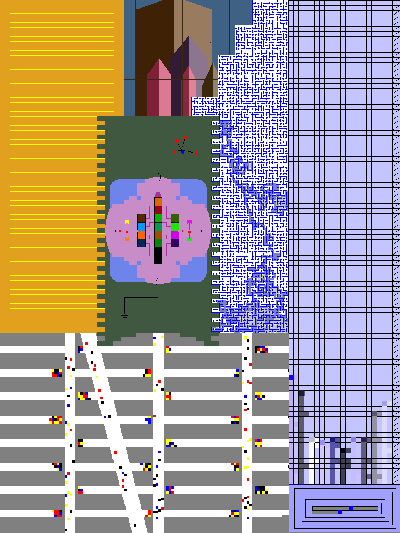
John F. Simon's ComplexCity (2000).
"I am never sure what it will do ... until
I run it"
Interview with John F. Simon Jr.
To really enjoy the creations of New York-based
John F. Simon Jr. (b. 1963) you often need to know a little
bit about them. Simon is a true 'nerd' artist with a background
in planetary and earth sciences and also art school. Years ago,
while looking for a creative outlet for his thoughts, he came across
Mondrian's Broadway Boogie Woogie (1942-43) - a graphical
drawing of Manhattan seen from above - and realized that art doesn't
need organic shapes. He made ComplexCity (2000), which is
also Manhattan but in Simon's version everything moves, controlled
by a computer program: cars drive, stop for red light, elevators
move up and down. ComplexCity is run by an old laptop - bought
on ebay (auction site ed.), the artist says - rebuilt as a screen
placed vertically on a wall. Kopenhagen e-mailed with the artist.
Interview by Kristine Ploug.
First, I would like to hear how you categorize
your work.
First of all my work is visual art. I make software artworks that
run on displays but I also make drawings on paper and computer controlled
laser cut objects.
You have done a number of panels - i.e. Every
Icon and ComplexCity - that have to be seen live, almost
like tangible art forms, and you have also done work that can be
seen online (but doesn't have to be experienced online), like Unfolding
Object that is currently on show on Guggenheims site. What do
you call your art?
I call ALL of it my art. It is easier for me to think of what I
do as a 'creative practice' that includes all manifestations of
my ideas.
Do you still do new panels? I noticed that you
wrote 1998-2001 on your site.
Most definitely! I haven't updated the site in a while - there are
a few new projects and panels. There will be a new panel made this
summer and shown in September (in Brye Wolkowitz - a new gallery
on 26th Street in New York City -ed.). It will be a group show with
Alan Rath, Jim Campbell and Steinna Vasulka.
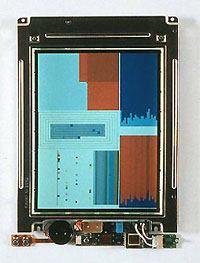 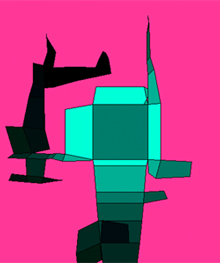
Left: Color Panel v1.0 (1999). Right: Unfolding
Object - currently on show at Guggenheim.org.
What is your work process? I am especially curious
about your digital works - what comes first, the idea or the software?
I work first from sketches. I try to study my creative process as
I draw and translate a few of my internal rules to code. Then I
look purely at the code, I have written. What variables have I chosen?
What happens when I modify the variables and move the code through
possibility space? I see what happens on the screen as I improvise
with the code and then sometimes return to drawing with those ideas.
I consider my work to include both the analogue and digital.
Do you believe you can reach some sort of new
level of creativity using software combined with analogue drawing
- or is that just your way of working?
I don't know the levels of creativity that you refer to. I do have
two creative sources in this process instead of one. Maybe this
is a new level? I know that when I write something in software,
I am never sure what it will do on the screen until I run it. I
describe something in code that will generate a graphic or an animation
and then run it to see the result. The result often surprises me
or leads me to a new way of thinking about the figure I'm creating.
These new looks make it back into my sketches where I improvise
on them a different way. I have, over the last 10 years of working
this way, moved a long way in what, how and why I create.
Even though you regard yourself as an artist,
plain and simple, you are often referred to as a digital artist
or software artist and one of the few people that work creatively
with programming. How do you feel about that - and what is your
attitude towards software art?
I am happy to be referred to at all! Labels are useful for setting
work in context but I try not to hold it too tightly or stick to
working a certain way because I'm identified that way. I love software
and I have called certain things that I did 'software art' for a
long time. My 'Every Icon' was certainly software art. I am very
interested in new software art projects that I see and in expanding
the definition of the field. Besides creating purely software artworks
I have used software to make pen drawings, linoleum floors, formica
walls and plastic souvenirs. I also spend a lot of time drawing
by hand on paper.
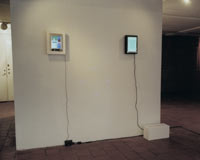

Left: Color Panel v1.0 and Every Icon at
Electrohypes biennial 2002. Right: Simon himself.
Last fall you exhibited at Electrohype in Malmoe
- a biennial for computer based art. There is a lot of discussion
going on about how to exhibit computer based art - whether it should
be exhibited in separate exhibitions or festivals or together with
tangible art forms in a more traditional fashion. What do you think?
Separate festivals are great for new ideas to help concentrate the
practitioners and focus the discussions. I had a great time in Malmoe
because it was well planned and I got to meet and have discussions
with lots of individuals. It doesn't always happen at larger festivals.
That being said, I think that we shouldn't loose the focus that
software art is a kind of art and work should also be done to define
the place for this work in the larger art world. I exhibited software
artworks last year at the Miami Basel Art Fair and at the Armory
Show here in New York - both very mainstream art world venues.
What triggered the idea for the panels? To show
digital art hanging on a wall, like a painting.
I was making drawings by writing my own software tools. I first
started to think about the panels when the subject matter of the
drawings changed from landscapes to catalogues of marks. The drawings
were static prints of a dynamic process. It occurred to me that
the appropriate way to see a dynamic process was in a dynamic medium.
I started buying used laptops, taking them apart, and letting my
software run on them. The pieces are dedicated to a single system
that evolves and never repeats.
One might think that the panels were a conscious
cross-over between genres - digital art to be hung on a wall…
A way to exhibit digital art. Did that not play a part at all?
Sure. Many threads were joined together in these panels. The panel
idea answered my theoretical concerns with dynamic drawing as I
said above. At the same time it was a way to encapsulate and display
software. It dedicated a piece of hardware to a piece of software
and it only needed to be turned on. Finally, the panels sold very
well so they became also an art market commodity and a way for me
to support myself and focus only on my art.
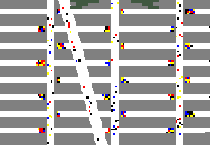 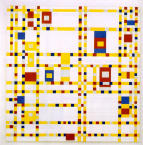
An element from Simon's ComplexCity (2000) and Mondrian's
Broadway Boogie Woogie (1942/1943)
You have some obvious connotations in some of
your work, i.e. ComplexCity. What are your inspirations?
I owe a tremendous amount to Paul Klee and his ideas about a dynamic
picture space. ComplexCity is based on a dialog between Stuart
Davis and Piet Mondrian. I also look at a lot of scientific imagery
(such as cellular automata) and maps. and use many of Edward Tufte's
ideas about informational display.
So basically you do contemporary art!!
Yes!
Do you have any 'idols' in the digital arts -
do you look to the digital arts for inspiration?
One of my favourite media works is Nam June Paik's sculpture of
a Buddha watching itself on television. I like a lot of digital
art but I think it's a very young medium and hard to 'idolize' anyone.
I still learn a lot from everyone in the field and the different
ways each artist approaches hardware and software.
You seem to consider art a commodity - i.e. you
sell souvenirs from you website…
Yes. I think being in New York with so many commercial galleries
and in the USA, where there is less government support contributes
to this attitude.
You also sell a version of the programs in your panels for buyers
to put on their computers.
No - the programs on the panels are only sold on the panels with
the exception of Every Icon which appears on panels, web, pilot,
projection, etc. There were some 'stand alone' software artworks
like Color Balance available early on.
Where do you think the art market is going in
connection to the digital arts?
There is a small niche which will probably grow as it merges into
video art and installation art.
Miltos Manetas says he believes web domains to
be the new art objects. What do you think?
I agree with him that electronic 'stuff' - web domains, software,
databases, are growing in importance. I am interested to see what
will become of it all in the future.
More …
John F. Simon Jr's site: http://www.numeral.com/
Unfolding object at the Guggenheim: http://www.guggenheim.org/internetart/internetart_index.html
Jon Ippolito's interview with John F. Simon Jr from 2002: http://www.guggenheim.org/internetart/internetart_index.html
Tilman Baumgaertel's interview with John F. Simon Jr from 1999:
http://www.nettime.org/Lists-Archives/nettime-l-9907/msg00067.html
|